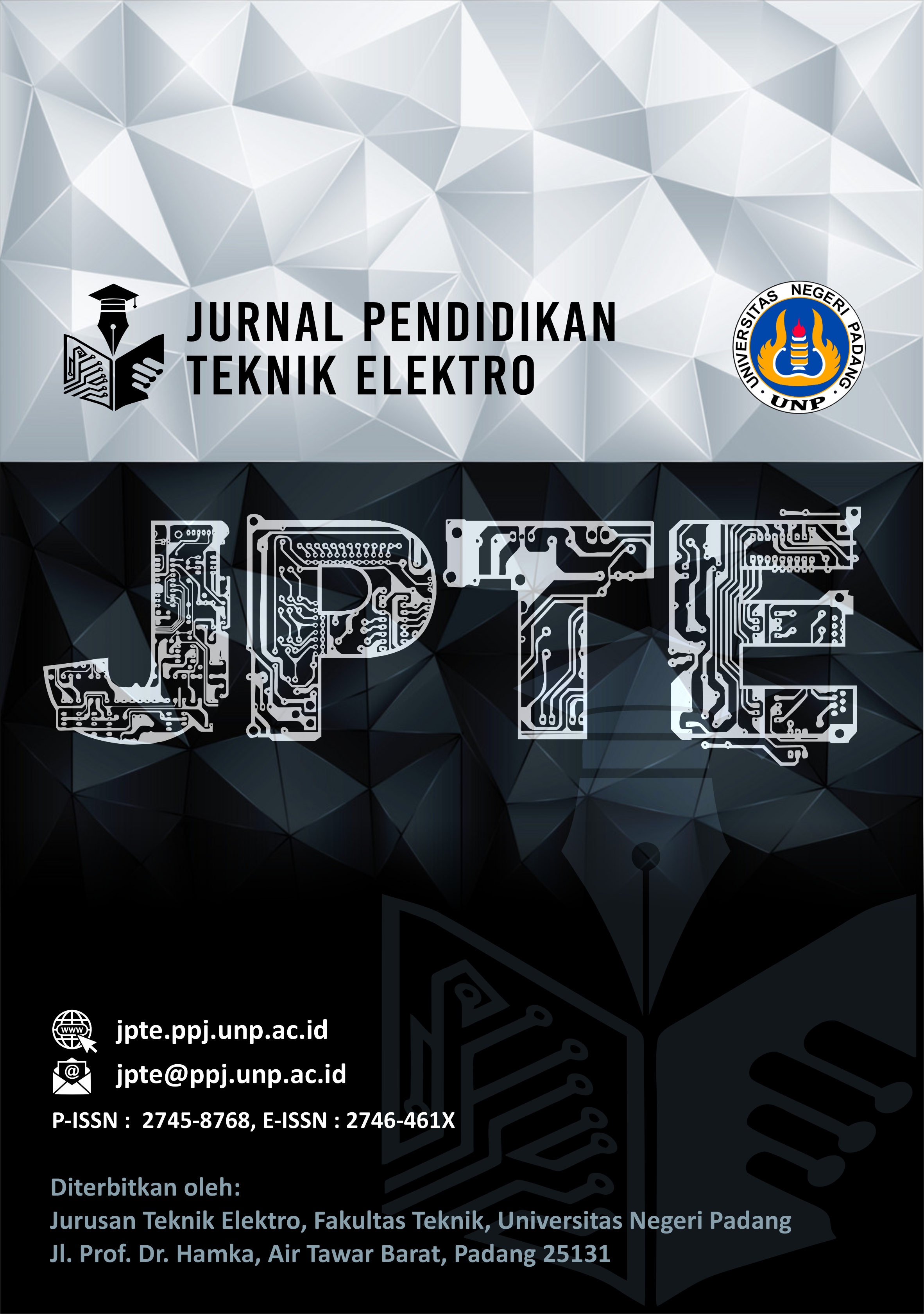Implementasi Project-Based Learning Pada Mata Pelajaran Instalasi Motor Listrik
##plugins.themes.academic_pro.article.main##
Abstract
Education plays an important role in the overall development of individual potential, as stipulated in the Law of the Republic of Indonesia Number 20 of 2003 concerning the National Education System. At the Vocational High School (SMK) level, education is oriented towards developing students' professional competencies following their fields. One of the subjects at SMK Negeri 2 Payakumbuh, especially in the Electrical Power Installation Engineering department, is Electric Motor Installation which involves theory and practice. However, observations show that learning tends to be passive, so students lack creativity and do not understand the material. This research aims to overcome these problems by applying the Project-Based Learning (PjBL) learning model. PjBL is an approach that involves students in designing and completing real projects, which aims to improve critical thinking skills, creativity, and collaboration. The method used in this research is a quantitative approach with a type of pre-experimental research, the pre-experimental research design used is One Shot Case Study. This design involves one group where the practicum value before the application of the Project-Based Learning model (O1), given treatment (X), and the practicum value after the application of the Project-Based Learning model (O2). The subjects of this study were students of class XI TITL 2 SMK Negeri 2 Payakumbuh in the 2024/2025 academic year
##plugins.themes.academic_pro.article.details##

This work is licensed under a Creative Commons Attribution 4.0 International License.
References
[2] D. T. P. Yanto, M. Kabatiah, H. Zaswita, G. Giatman, and H. Effendi, “Development of Virtual Learning using Problem-Based Learning Models for Vocational Education Students,” ELINVO (Electronics, Informatics, and Vocational Education), vol. 7, no. 2, pp. 163–172, 2022, doi: 10.21831/elinvo.v7i2.52473.
[3] C. Antonietti, A. Cattaneo, and F. Amenduni, “Can teachers’ digital competence influence technology acceptance in vocational education?,” Comput Human Behav, vol. 132, p. 107266, Jul. 2022, doi: https://doi.org/10.1016/J.CHB.2022.107266.
[4] T. Maysuri and J. Sopacua, “Pengaruh Penerapan Model Pembelajaran Project Based Learning dalam Upaya Meningkatkan Hasil Belajar pada SMA Negeri 3 Maluku Tengah,” 2024, doi: 10.24815/jimps.v9i4.32918.
[5] D. T. P. Yanto, Ganefri, Sukardi, J. P. Yanto, R. Kurani, and Muslim, “Engineering Students’ Acceptance of Augmented Reality Technology Integrated with E-Worksheet in The Laboratory Learning,” International Journal of Online and Biomedical Engineering (iJOE), vol. 20, no. 03, pp. 39–54, Feb. 2024, doi: 10.3991/ijoe.v20i03.46101.
[6] N. Ruwanda, E. Andriana, and S. Rokhmanah, “Penerapan Model PjBL Dalam Meningkatkan Kreatifitas Belajar Peserta Didik,” Jurnal Ilmiah PGSD FKIP, vol. 09, Dec. 2023.
[7] E. A. Datundugon, N. Sangi, and A. Wajong, “Pengaruh Model Pembelajaran Berbasis Proyek terhadap Hasil Belajar Instalasi Listrik Bangunan Sederhana,” 2021.
[8] D. T. P. Yanto et al., “Innovative Laboratory Learning: A Study Evaluating the Practicality of Integrated E-Worksheets with Augmented Reality in Electrical Machines Course,” International Journal of Information and Education Technology, vol. 14, no. 7, pp. 996–1005, 2024, doi: 10.18178/ijiet.2024.14.7.2127.
[9] O. : Yanuar, E. Saputra, F. T. Universitas, and N. Yogyakarta, “Penerapan Model Pembelajaran Project Based Learning (Pjbl) Untuk Meningkatkan Keaktifan Dan Hasil Belajar Perekayasaan Sistem Kontrol Siswa Kelas Xii Ei 3 Smk N 3 Wonosari,” Mar. 2016.
[10] Halwati Najwa, “Efektivitas Penerapan Metode Pjbl Dengan Perangkat Lunak Sketchup Dalam Meningkatkan Hasil Belajar Siswa SMK ,” Educatioanl Journal: General and Specific Research, vol. 4, no. Juni, pp. 256–262, 2024.
[11] M. N. Rahmat, “Pemanfaatan Model Pembelajaran Project Based Learning (PjBL) untuk Mengasah Kreativitas dan Meningkatkan Hasil Belajar Siswa pada Mata Pelajaran Dasar Pemrograman,” Jurnal Media Pendidikan Teknik Informatika dan Komputer, vol. 7, no. 3, 2024.
[12] Sugiyono, Metode Penelitian Kuantitatif Kualitatif dan R&D. Bandung. Bandung: Alpabeta, 2013.
[13] D. T. P. Yanto, E. Astrid, and R. Hidayat, “The achievement of four student competencies in domestic electrical installations using a project-based learning model,” in Borderless Education as a Challenge in the 5.0 Society: Proceedings of the 3rd International Conference on Educational Sciences (ICES 2019), Bandung: Routledge, 2020, p. 349.
[14] F. Eliza, S. Suriyadi, and D. T. P. Yanto, “Penerapan Model Pembelajaran Project Based Learning untuk Meningkatkan Hasil Belajar Siswa,” vol. 1, no. 1, pp. 2–5, 2017.
[15] F. Ramadhanil Haq, “Penerapan Model Project-Based Learning pada Mata Pelajaran Instalasi Penerangan Listrik,” Jurnal Pendidikan Teknik elektro, vol. 03, no. 02, 2022.
[16] A. Dwiantoro and I. Basuki, “Analisis Pengaruh Model Pembelajaran Project Based Learning,” 2021.

